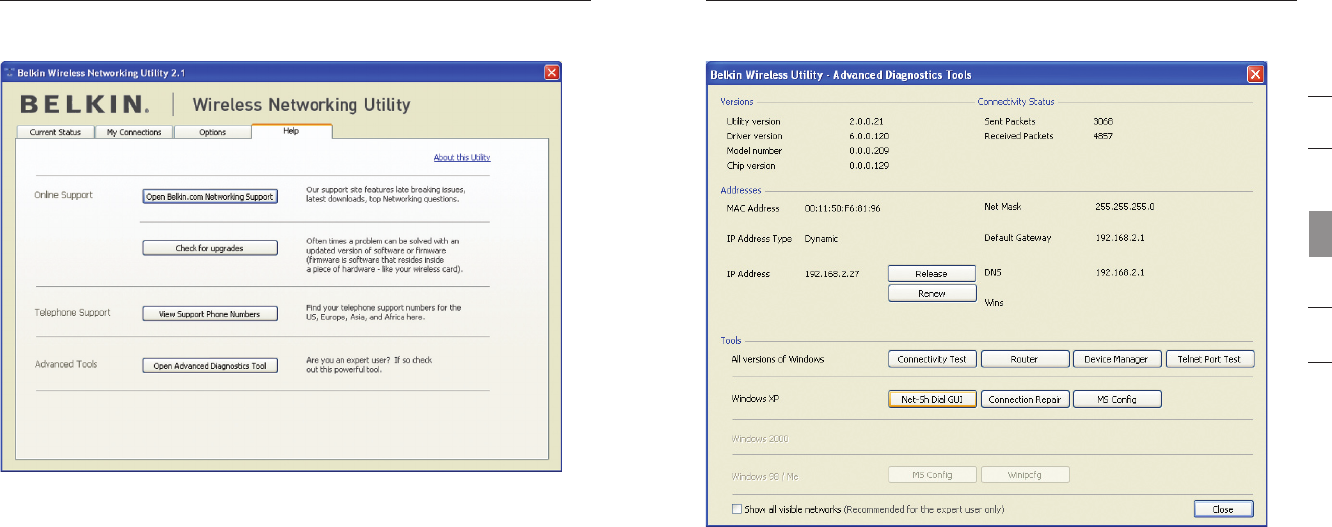Belkin F5D8011B N1 Wireless Notebook Card User Manual P75172 F5D8011 man indd
Belkin International, Inc. N1 Wireless Notebook Card P75172 F5D8011 man indd
Belkin >
Part 3

2928
Using the Belkin Wireless Networking Utility
Using the Belkin Wireless Networking Utility
29
section
1
2
3
4
5
6
Advanced Diagnostic Tools
The “Advanced Diagnostic Tools” section is the central control panel
for all the settings of the hardware and software components of
the wireless network. It provides an array of tests and connectivity
services to ensure optimal network performance.

3130
Troubleshooting
Troubleshooting
31
section
1
2
3
4
5
6
I can’t connect to the Internet wirelessly.
If you are unable to connect to the Internet from a wireless computer,
please check the following items:
1. Look at the lights on your wireless router. If you’re using a Belkin
Wireless Router, the lights should be as follows:
• The “Power” light should be on.
• The “Connected” light should be on, and not blinking.
• The “WAN” light should be either on or blinking.
If your Belkin Wireless Router’s lights have the above characteristics, go
to number 2 below.
If this is NOT the case, make sure:
• The router’s power cord is plugged in.
• All cables are connected between the router and the modem.
• All the modem’s LEDs are functioning correctly. If not, see your
modem’s user manual.
• Reboot the router.
• Reboot the modem.
If you continue to have issues, please contact Belkin Technical Support.
If you are not using a Belkin Wireless Router, consult that router
manufacturer’s user guide.
2. Open your wireless utility software by clicking on the icon in the
system tray at the bottom right-hand corner of the screen. If you’re
using a Belkin Wireless Card, the tray icon should look like this
(the icon may be red or green):
3. The exact window that opens will vary depending on the model of
wireless card you have; however, any of the utilities should have a list
of “Available Networks”.
Available networks are wireless networks to which you can connect.
If you are using a Belkin 802.11g (G Plus) Router, or Belkin 802.11g
(54g) Router, “Belkin54g” is the default name.
If you are using a Belkin 802.11b Router, the default name should
be “WLAN”.
If you are NOT using a Belkin Router, please consult your router
manufacturer’s user manual for the default name.
The name of your wireless network appears in
“Available Networks”.
If the correct network name is listed in the “Available Networks”
list, please follow the steps below to connect wirelessly:
1. Click on the correct network name in the “Available Networks” list.
2. If the network has security (encryption) enabled, you will
need to enter the network key. Click “Connect”. For more
information regarding security, see the page entitled: “Securing
your Wi-Fi Network” on page 17 of this User Manual.
3. Within a few seconds, the tray icon in the lower
right-hand corner of your screen should turn green,
indicating a successful connection to the network.
If you are still unable to access the Internet after connecting to
the wireless network, please contact Belkin Technical Support.
The name of your wireless network DOES NOT appear in the list
of “Available Networks”.
If the correct network name is not listed, check the SSID settings
to see if they match. The SSID is case-sensitive and the spelling
on each computer must be exactly the same in order for the Card
to connect to the wireless router (or access point).
Note: To check the SSID settings or look for an available network,
double-click the Signal Indicator icon to bring up the “Wireless
Networks” screen. Click “Add” if you do not see the network
you are trying to connect to and type in the SSID. For more
information about setting up an SSID, please reference your
router manufacturer’s user manual.
If issues persist even at close range, please contact Belkin
Technical Support.

3332
33
section
1
2
3
4
5
6
TroubleshootingTroubleshooting
Installation CD-ROM does not start Belkin
Wireless Networking Utility.
If the CD-ROM does not start the Belkin Wireless Networking
Utility automatically, it could be that the computer is running
other applications that are interfering with the CD drive. If the
Belkin Wireless Networking Utility screen does not appear within
15-20 seconds, open up your CD-ROM drive by double-clicking
on the “My Computer” icon. Next, double-click on the CD-ROM
drive that the Installation CD has been placed in to start the
installation. Then double-click on the folder named “Files”. Next,
double-click on the icon named “setup.exe”.
Power LED does not come ON; Card is not working.
If the LED indicators are not ON, the problem may be that the
Card is not connected or installed properly. Verify that the Card is
plugged firmly into the CardBus slot of your computer. Check to
see that the drivers for the Card have been installed. Right-click
on the “My Computer” icon on your desktop. Choose “Properties”
and navigate to the “Device Manager” and see if your CardBus
Card is listed without any errors. If an error is indicated, contact
Belkin Technical Support.
Link LED is blinking slowly; I cannot connect to a
wireless network or the Internet.
If your Card appears to be functioning properly, but you cannot
connect to a network or you have a red wireless icon at the
bottom of your screen, the problem may be that there is a
mismatch between the network name (SSID) settings in your
wireless network properties.
Check the SSID settings to see if they match. The SSID is case-
sensitive and the spelling on each computer must be exactly the
same in order for the Card to connect to the wireless router (or
access point).
Note: To check the SSID settings or look for an available
network, double-click the Signal Indicator icon to bring up the
“Wireless Networks” screen. Click “Add” if you do not see the
network you are trying to connect to and type in the SSID.
For more information about setting up an SSID, please reference
your router manufacturer’s user manual.
If issues persist even at close range, please contact Belkin
Technical Support.
Link LED is solid but I cannot connect to the Internet.
If you have a signal but can’t get online or obtain an IP address,
the problem may be that there is a mismatch between the
encryption key settings in your computer and wireless router (or
access point). Check the WEP, WPA, or WPA2 key settings to see
if they match. The key is case-sensitive and the spelling on each
computer and wireless router (or access point) must be exactly
the same in order for the Card to connect to the router. For more
information about encryption, please see “Securing your Wi-Fi
Network” on page 17 of this User Manual.
If issues persist even at close range, please contact Belkin
Technical Support.
Data transfer is sometimes slow.
Wireless technology is radio-based, which means connectivity
and the throughput performance between devices decreases
when the distance between devices increases. Other factors that
will cause signal degradation (metal is generally the worst culprit)
are obstructions such as walls and metal appliances. As a result,
the typical indoor range of your wireless devices will be between
100 to 200 feet. Note also that connection speed may decrease
as you move farther from the wireless router (or access point).
In order to determine if wireless issues are related to range, we
suggest temporarily moving the computer, if possible, to five to
10 feet away from the wireless router (or access point). Please
see the section titled “Placement of your Wireless Networking
Hardware for Optimal Performance” on page 2 of this User
Manual. If issues persist even at close range, please contact
Belkin Technical Support.
Signal strength is poor.
Wireless technology is radio-based, which means connectivity
and the throughput performance between devices decreases
when the distance between devices increases. Other factors that
will cause signal degradation (metal is generally the worst culprit)
are obstructions such as walls and metal appliances. As a result,
the typical indoor range of your wireless devices will be between
100 to 200 feet. Note also that connection speed may decrease
as you move farther from the wireless router (or access point).
In order to determine if wireless issues are related to range, we
suggest temporarily moving the computer, if possible, to five to
10 feet away from wireless router (or access point).

3534
35
section
1
2
3
4
5
6
TroubleshootingTroubleshooting
Changing the wireless channel – Depending on local wireless
traffic and interference, switching the wireless channel of your
network can improve performance and reliability. The default
channel the router is shipped with is channel 6. You may choose
from several other channels depending on your region; see your
router’s (or access point’s) user manual for instructions on how to
choose other channels.
Limiting the wireless transmit rate – Limiting the wireless
transmit rate can help improve the maximum wireless range, and
connection stability. Most wireless cards have the ability to limit
the transmission rate. To change this property, go to the Windows
Control Panel, open “Network Connections” and double-click
on your Card’s connection. In the “Properties” dialog, select the
“Configure” button on the “General” tab (Windows 98 users will
have to select the Wireless Card in the list box and then click
“Properties”), then choose the “Advanced” tab and select the rate
property. Wireless client cards are usually set to automatically
adjust the wireless transmit rate for you, but doing so can cause
periodic disconnects when the wireless signal is too weak; as a
rule, slower transmission rates are more stable. Experiment with
different connection rates until you find the best one for your
environment; note that all available transmission rates should
be acceptable for browsing the Internet. For more assistance,
see your wireless card’s literature. If issues persist even at close
range, please contact Belkin Technical Support.
Why are there two wireless utilities in my system tray?
Which one do I use?
There are several features and advantages from using the Belkin
Wireless Networking Utility over the Windows XP Wireless
Zero Configuration utility. We offer a site survey, detailed link
information, and adapter diagnosis, to name a few.
It’s essential to know which utility is managing your Card. We
recommend using the Belkin Wireless Networking Utility. To use
the Belkin Wireless Networking Utility, follow the steps below:
Step 1 Right-click on the network status icon in the system tray
and select the “Status” tab.
Step 2 From the “Status” tab, uncheck the “Use Windows to
configure my wireless network settings” box. Once the box is
unchecked, click the “Close” button to close the window.
You are now using the Belkin Wireless Networking Utility to
configure the Card.
Card does not perform or connection is unstable when
computer has a second built-in wireless network card
(such as a mini PCI or Intel® Centrino™).
This condition occurs if your computer h as a built-in wireless
card while your Belkin Wireless Card is also active. This
happens because Windows must now handle two active
wireless connections.
You need to disable the built-in wireless card from your computer
under “Network Adapters” in the Device Manager.
Card does not perform or connection is slow when
computer has a built-in wired Ethernet card.
This condition occurs if your computer has an active Ethernet
card while your Wireless Card is also active. This happens
because Windows must now handle two active network
connections. You need to disable the Ethernet card from your
computer under “Network Adapters” in the Device Manager.
What’s the difference between 802.11b, 802.11g, 802.11a,
and draft 802.11n?
Currently there are four levels of wireless networking standards,
which transmit data at very different maximum speeds. Each is
based on the designation for certifying network standards. The
most common wireless networking standard, 802.11b, transmits
information at 11Mbps; 802.11a and 802.11g work at 54Mbps;
and draft 802.11n works at 108Mbps. See the chart on the next
page for more detailed information.

3736
37
section
1
2
3
4
5
6
TroubleshootingTroubleshooting
Wireless Comparison Chart
Wireless
Technology
802.11b
G
(802.11g)
G Plus
(802.11g with
HSM)
G Plus MIMO
(802.11g with
MIMO MRC)
N1 MIMO
(draft 802.11n
with MIMO)
Speed*
11Mbps link
rate/baseline
5x faster than
802.11b*
10x faster
than 802.11b*
10x faster than
802.11b*
Wired speed
over the air*
Frequency
Common
household
devices such
as cordless
phones and
microwave
ovens may
interfere with
the unlicensed
band 2.4GHz
Common
household
devices such
as cordless
phones and
microwave
ovens may
interfere with
the unlicensed
band 2.4GHz
Common
household
devices such
as cordless
phones and
microwave
ovens may
interfere with
the unlicensed
band 2.4GHz
Common
household
devices such
as cordless
phones and
microwave
ovens may
interfere with
the unlicensed
band 2.4GHz
Common
household
devices such
as cordless
phones and
microwave
ovens may
interfere with
the unlicensed
band 2.4GHz
Compatibility
Compatible
with 802.11g
Compatible
with 802.11b/g
Compatible
with 802.11b/g
Compatible
with 802.11b/g
Compatible
with draft
802.11n** and
802.11b/g
Coverage*
Typically
100–200 ft.
indoors
Up to 400 ft.* Up to 700 ft.* Up to 1,000 ft.* Up to 1,400 ft.*
Advantage
Mature—legacy
technology
Common—
widespread
use for Internet
sharing
Enhanced
speed and
coverage
Better coverage
and consistent
speed at range
Leading
edge— best
coverage and
throughput
*Distance and connection speeds will vary depending on your networking environment.
**This Card is compatible with products based on the same version of the draft 802.11n
specifications, and may require a software upgrade for best results.
Technical Support
You can find technical support information at www.belkin.com/
networking. If you want to contact technical support by phone,
please call:
US: 877-736-5771
Europe: 00 800 223 55 460
Australia: 1800 235 546
New Zealand: 0800 235 546
Singapore: 800 616 1790

3938
Information
Information
39
section
1
2
3
4
5
6
Modifications
The FCC requires the user to be notified that any changes or modifications to
this device that are not expressly approved by Belkin Corporation may void
the user’s authority to operate the equipment.
Belkin Corporation Limited Lifetime Product Warranty
What this warranty covers.
Belkin Corporation warrants to the original purchaser of this Belkin product
that the product shall be free of defects in design, assembly, material,
or workmanship.
What the period of coverage is.
Belkin Corporation warrants the Belkin product for the lifetime of the product.
What will we do to correct problems?
Product Warranty.
Belkin will repair or replace, at its option, any defective product free of charge
(except for shipping charges for the product).
What is not covered by this warranty?
All above warranties are null and void if the Belkin product is not provided to
Belkin Corporation for inspection upon Belkin’s request at the sole expense
of the purchaser, or if Belkin Corporation determines that the Belkin product
has been improperly installed, altered in any way, or tampered with. The
Belkin Product Warranty does not protect against acts of God (other than
lightning) such as flood, earthquake, war, vandalism, theft, normal-use wear
and tear, erosion, depletion, obsolescence, abuse, damage due to low
voltage disturbances (i.e. brownouts or sags), non-authorized program, or
system equipment modification or alteration.
How to get service.
To get service for your Belkin product you must take the following steps:
1. Contact Belkin Corporation at 501 W. Walnut St., Compton CA 90220,
Attn: Customer Service, or call (800)-223-5546, within 15 days of the
Occurrence. Be prepared to provide the following information:
a. The part number of the Belkin product.
b. Where you purchased the product.
c. When you purchased the product.
d. Copy of original receipt.
2. Your Belkin Customer Service Representative will then instruct you on
how to forward your receipt and Belkin product and how to proceed
with your claim.
FCC Statement
DECLARATION OF CONFORMITY WITH FCC RULES FOR
ELECTROMAGNETIC COMPATIBILITY
We, Belkin Corporation, of 501 West Walnut Street,
Compton, CA 90220, declare under our sole responsibility
that the product,
F5D8011
to which this declaration relates, complies with Part 15
of the FCC Rules. Operation is subject to the following
two conditions: (1) this device may not cause harmful
interference, and (2) this device must accept any
interference received, including interference that may
cause undesired operation.
Caution: Exposure to Radio Frequency Radiation.
The radiated output power of this device is far below the FCC radio frequency
exposure limits. Nevertheless, the device shall be used in such a manner that
the potential for human contact during normal operation is minimized.
When connecting an external antenna to the device, the antenna shall be
placed in such a manner to minimize the potential for human contact during
normal operation. In order to avoid the possibility of exceeding the FCC radio
frequency exposure limits, human proximity to the antenna shall not be less
than 20cm (8 inches) during normal operation.
Federal Communications Commission Notice
This equipment has been tested and found to comply with the limits for a
Class B digital device, pursuant to Part 15 of the FCC Rules. These limits are
designed to provide reasonable protection against harmful interference in a
residential installation.
This equipment generates, uses, and can radiate radio frequency energy.
If this equipment does cause harmful interference to radio or television
reception, which can be determined by turning the equipment off and on, the
user is encouraged to try and correct the interference by one or more of the
following measures:
• Reorient or relocate the receiving antenna.
• Increase the distance between the equipment and the receiver.
• Connect the equipment to an outlet on a circuit different from that to
which the receiver is connected.
• Consult the dealer or an experienced radio/TV technician for help.

40
Information
Information
41
n
o
i
t
c
e
s
1
2
3
4
5
6
Belkin Corporation reserves the right to review the damaged Belkin product.
All costs of shipping the Belkin product to Belkin Corporation for inspection
shall be borne solely by the purchaser. If Belkin determines, in its sole
discretion, that it is impractical to ship the damaged equipment to Belkin
Corporation, Belkin may designate, in its sole discretion, an equipment repair
facility to inspect and estimate the cost to repair such equipment. The cost,
if any, of shipping the equipment to and from such repair facility and of such
estimate shall be borne solely by the purchaser. Damaged equipment must
remain available for inspection until the claim is finalized. Whenever claims
are settled, Belkin Corporation reserves the right to be subrogated under
any existing insurance policies the purchaser may have.
How state law relates to the warranty.
THIS WARRANTY CONTAINS THE SOLE WARRANTY OF BELKIN
CORPORATION, THERE ARE NO OTHER WARRANTIES, EXPRESSED
OR, EXCEPT AS REQUIRED BY LAW, IMPLIED, INCLUDING THE IMPLIED
WARRANTY OR CONDITION OF QUALITY, MERCHANTABILITY OR FITNESS
FOR A PARTICULAR PURPOSE, AND SUCH IMPLIED WARRANTIES, IF ANY,
ARE LIMITED IN DURATION TO THE TERM OF THIS WARRANTY.
Some states do not allow limitations on how long an implied warranty lasts,
so the above limitations may not apply to you.
IN NO EVENT SHALL BELKIN CORPORATION BE LIABLE FOR INCIDENTAL,
SPECIAL, DIRECT, INDIRECT, CONSEQUENTIAL OR MULTIPLE DAMAGES
SUCH AS, BUT NOT LIMITED TO, LOST BUSINESS OR PROFITS ARISING
OUT OF THE SALE OR USE OF ANY BELKIN PRODUCT, EVEN IF ADVISED
OF THE POSSIBILITY OF SUCH DAMAGES.
This warranty gives you specific legal rights, and you may also have other
rights, which may vary from state to state. Some states do not allow the
exclusion or limitation of incidental, consequential, or other damages, so the
above limitations may not apply to you.
This device has been tested and meets the FCC RF Exposure guidelines.
The maximum SAR value reported is 0.31.

Belkin Ltd.
7 Bowen Crescent, West Gosford
NSW 2250, Australia
+61 (0) 2 4372 8600
+61 (0) 2 4372 8603 fax
Belkin B.V.
Boeing Avenue 333
1119 PH Schiphol-Rijk, The Netherlands
+31 (0) 20 654 7300
+31 (0) 20 654 7349 fax
Belkin Tech Support
US: 877-736-5771
310-898-1100 ext. 2263
Europe: 00 800 223 55 460
Australia: 1800 235 546
New Zealand: 0800 235 546
Singapore: 800 616 1790
Belkin Corporation
501 West Walnut Street
Los Angeles, CA 90220-5221, USA
310-898-1100
310-898-1111 fax
Belkin Ltd.
Express Business Park, Shipton Way
Rushden, NN10 6GL, United Kingdom
+44 (0) 1933 35 2000
+44 (0) 1933 31 2000 fax
© 2006 Belkin Corporation. All rights reserved. All trade names are registered trademarks of respective
manufacturers listed. The mark Wi-Fi is a registered mark of the Wi-Fi Alliance. The “Wi-Fi CERTIFIED”
logo is a certification mark of the Wi-Fi Alliance.
P75172
N1 Wireless
Notebook Card